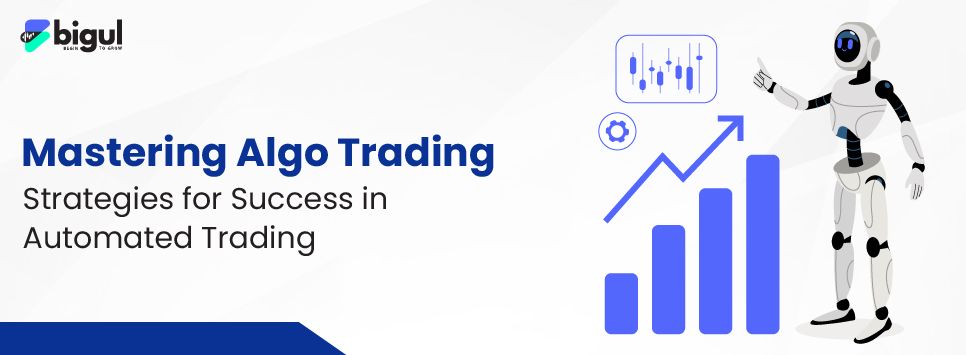Introduction
In cutting-edge speedy-paced economic markets, technology performs a critical role in buying and selling. Algo trading, additionally known as algorithmic buying and selling, has emerged as a popular method for executing trades with the assistance of computerised structures and laptop algorithms. This progressive approach has changed the way financial transactions are conducted, bringing speed, efficiency, and accuracy to the trading system.
Automated trading holds great significance in the modern financial market. It eliminates human emotions and biases from the decision-making process, enabling traders to execute trades based on predefined algorithms and strategies. By leveraging advanced mathematical models and historical data analysis, algo trading helps investors capitalise on market opportunities in real-time.
Understanding Algo Trading
Algo buying and selling, also called algorithmic trading, is a method of executing trades in financial markets using laptop algorithms. It entails using pre-programmed commands that automatically execute trades primarily based on specific conditions, such as charge, volume, or timing. Algo trading has received a large reputation in recent years because of its capacity to analyse good sized quantities of facts and execute trades at excessive speeds, offering several blessings and advantages for investors.
Advantages and Benefits of Algo Trading:
1. Efficient and Timely Execution: Algo trading enables trades to be executed instantly and efficiently, eliminating the need for manual intervention and reducing the risk of delays or human errors.
2. Increased Accuracy: Algorithms follow predefined rules, removing the emotional biases that can often impact human decision-making, leading to more accurate and objective trading decisions.
3. Enhanced Liquidity: Algo trading strategies can improve market liquidity by providing continuous buy and sell orders, ensuring better price discovery and reducing bid-ask spreads.
4. Improved Risk Management: Algorithms can incorporate risk management parameters, such as stop-loss orders and position limits, to help control potential losses and manage overall portfolio risk.
5. Scalability and Consistency: Algo trading allows traders to scale their strategies and execute trades across multiple markets or instruments consistently, without being limited by human capacity.
Common Algorithms Used in Algo Trading:
1. Trend-following Algorithms: These algorithms identify and take advantage of market trends, either upward or downward, by following price movements.
2. Mean Reversion Algorithms: These algorithms capitalise on the concept that prices tend to revert to their mean or average values after deviating from them.
3. Statistical Arbitrage Algorithms: These algorithms exploit price discrepancies between related securities, taking advantage of statistical models and market inefficiencies.
4. Market-making Algorithms: These algorithms provide liquidity to the market by continuously quoting both buy and sell prices, profiting from the bid-ask spread.
5. Volume Weighted Average Price (VWAP) Algorithms: These algorithms aim to execute trades at the volume-weighted average price over a given time period, minimising market impact.
Getting Started with Bigul – The Trading App
Bigul is a user-friendly and powerful trading app designed to make algo trading accessible to everyone. With its intuitive features and robust functionality, Bigul offers numerous benefits for those interested in automated trading. Whether you are a beginner or an experienced trader, Bigul can be your go-to platform for executing algorithmic trading strategies effectively.
One of the key features of Bigul is its simplicity, making it easy for users to navigate and operate. Here are some features and benefits of using Bigul for algo trading:
1. User-Friendly Interface: Bigul provides a clean and intuitive user interface, allowing users to easily navigate through different sections and features.
2. Strategy Builder: Bigul offers a built-in strategy builder that enables users to create and customise their own trading strategies without any coding knowledge.
3. Backtesting and Simulation: Users can test their trading strategies using historical data to assess their performance and make necessary adjustments.
4. Real-Time Market Data: Bigul provides real-time market data and charts to help users analyse market trends and make informed trading decisions.
5. Multiple Exchanges and Instruments: Bigul supports trading on multiple exchanges and offers a wide range of instruments including stocks, futures, options, and more.
6. Risk Management Tools: Bigul includes risk management tools such as stop-loss orders and position sizing to help users manage their risk effectively.
To get started with Bigul, follow these simple steps:
1. Sign up for an Account: Visit the Bigul website or download the app from your device’s app store. Sign up by providing the required information.
2. Verify Your Account: Complete the verification process by submitting the necessary documents as per the platform’s guidelines.
3. Fund Your Account: Deposit funds into your Bigul account using the available payment methods.
4. Explore the User Interface: Familiarise yourself with the different sections and features of Bigul, such as the trading dashboard, strategy builder, market data, and order execution.
5. Customise Your Trading Preferences: Set your preferred trading parameters and customise your trading strategies according to your risk appetite and investment goals.
With its user-friendly interface and powerful features, Bigul simplifies the process of algo trading, making it accessible to traders of all levels of experience. Start your algo trading journey on Bigul and unlock the potential of automated trading for better trading outcomes.
Strategies for Success in Algo Trading
Here are the key strategies to consider:
A. Building a Robust Trading System:
1. Defining Trading Goals and Objectives: Clearly identify your financial goals and what you aim to achieve through Algo Trading.
2. Selecting the Right Time Frame and Market: Determine the timeframe and market that align with your trading goals and risk tolerance.
3. Backtesting and Optimising Trading Strategies: Test your trading strategies using historical data to assess their effectiveness and make necessary adjustments.
4. Risk Management and Position Sizing: Implement risk management techniques, such as setting stop-loss orders and determining appropriate position sizes to manage potential losses.
5. Monitoring and Evaluation of Trading Performance: Continuously monitor and evaluate your trading performance to identify strengths, weaknesses, and areas for improvement.
B. Common Algo Trading Strategies and Techniques:
1. Momentum Trading: Capitalise on the price trends of specific stocks or assets by entering positions in the direction of the prevailing market momentum.
2. Breakout Trading: Identify key price levels where a breakout is likely to occur, and enter positions when the price surpasses these levels, anticipating a significant price movement.
3. Pairs Trading: Simultaneously trade two correlated instruments (such as two stocks or two indices) to take advantage of temporary price imbalances between them.
4. Arbitrage Trading: Exploit price discrepancies across different markets or exchanges to generate profits with minimal risk.
5. Statistical Analysis and Machine Learning in Algo Trading: Utilise statistical models and machine learning algorithms to identify patterns, predict price movements, and make informed trading decisions.
By following these strategies and techniques, you can increase your chances of success in Algo Trading while minimising risks. Remember to continually adapt and improve your trading system based on performance analysis.
Best Practices for Algo Trading on Bigul
When it comes to Algo trading on Bigul, following these best practices can significantly improve your chances of success. Let’s explore them in simple and easy-to-understand terms:
A. Choosing the Right Stocks or Instruments:
1. Identify stocks or instruments with sufficient liquidity and trading volume.
2. Focus on assets that align with your trading strategy and goals.
3. Consider factors such as volatility and correlation to optimise your portfolio.
B. Implementing Effective Risk Management Techniques:
1. Set clear risk parameters and adhere to them strictly.
2. Diversify your portfolio to minimise exposure to individual assets.
3. Use stop-loss orders to limit potential losses.
C. Using Advanced Order Types and Execution Strategies:
1. Explore different order types, such as limit orders and market orders, to control execution.
2. Utilise advanced execution strategies like time-weighted average price (TWAP) or volume-weighted average price (VWAP) to optimise order execution.
D. Leveraging Real-Time Data and Market News:
1. Stay informed about real-time market data and news to make informed trading decisions.
2. Utilise technical analysis indicators and chart patterns for better insights.
3. Consider using sentiment analysis tools to gauge market sentiment.
E. Regularly Reviewing and Updating Algo Trading Strategies:
1. Monitor the performance of your trading strategies and make adjustments as needed.
2. Stay updated with the latest market trends and adjust your strategies accordingly.
3. Regularly backtest and optimise your algorithms to improve performance.
Conclusion
In conclusion, let’s recap the key takeaways from this guide on mastering algo trading and using the Bigul trading app. Algo trading, or automated trading, is a powerful tool that can help you make smarter investment decisions and take advantage of market opportunities. By using algorithms, you can execute trades quickly and efficiently, saving time and minimising human errors. We explored the basics of algo trading and discussed common algorithms used in this strategy, such as trend-following and mean reversion. We also learned about the benefits of using the Bigul trading app, which provides a user-friendly interface and advanced features to support your algo trading journey.
Mastering algo trading requires building a robust trading system, backtesting and optimization strategies, and implementing effective risk management techniques. We also explored various algo trading strategies, including momentum trading and statistical analysis. In our final thoughts, we encourage you to start your algo trading journey with Bigul. The app offers a seamless trading experience and provides access to real-time data and market news. Remember to choose the right stocks or instruments, practise good risk management, and regularly review and update your trading strategies.
Also Read:
-
Algo Trading vs Traditional Trading: Which Approach is Right for You?
- Algorithmic Trading: The Fastest Way to Trade

.jpg)






.jpg)
.jpg)
